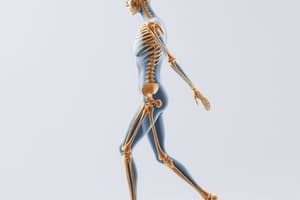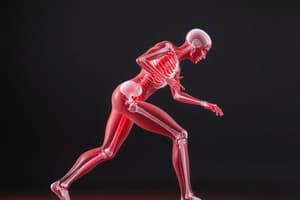Podcast
Questions and Answers
What does kinesiology primarily encompass?
What does kinesiology primarily encompass?
- Nutrition and wellness
- Psychology and sociology
- Human movement and related sciences (correct)
- Medicine and surgery
Which area of study in kinesiology focuses on the mechanical aspects of human movement?
Which area of study in kinesiology focuses on the mechanical aspects of human movement?
- Biomechanics (correct)
- Physiology
- Neuromuscular Control
- Anatomy
What is the main focus of physiology within kinesiology?
What is the main focus of physiology within kinesiology?
- Designing ergonomic workspaces
- Studying structural anatomy
- Analyzing movement patterns
- Investigating energy systems and muscular function (correct)
Which application of kinesiology aims to improve safety and efficiency in the workplace?
Which application of kinesiology aims to improve safety and efficiency in the workplace?
In research methods of kinesiology, what characterizes experimental studies?
In research methods of kinesiology, what characterizes experimental studies?
What distinguishes kinetic analysis from kinematic analysis?
What distinguishes kinetic analysis from kinematic analysis?
Which of the following is NOT a career opportunity typically associated with kinesiology?
Which of the following is NOT a career opportunity typically associated with kinesiology?
What current trend in kinesiology emphasizes the connection between physical movement and emotional well-being?
What current trend in kinesiology emphasizes the connection between physical movement and emotional well-being?
Study Notes
Definition
- Kinesiology: The scientific study of human movement, encompassing biomechanics, anatomy, physiology, and neuroscience.
Key Areas of Study
-
Biomechanics
- Examines the mechanical aspects of human movement.
- Focuses on forces, motion, and the structure of the musculoskeletal system.
-
Anatomy
- Studies the structure of the body and its parts.
- Includes functional anatomy, which relates structure to movement.
-
Physiology
- Investigates how the body's systems respond to physical activity.
- Covers topics such as muscular function and energy systems.
-
Neuromuscular Control
- Explores the nervous system's role in coordinating movement.
- Involves understanding motor learning and motor control.
Applications of Kinesiology
- Rehabilitation: Aiding recovery from injuries through therapeutic exercise.
- Sports Performance: Enhancing athletic performance via training and technique analysis.
- Ergonomics: Designing work environments to improve safety and efficiency.
- Health Promotion: Encouraging active lifestyles to prevent diseases related to inactivity.
Research Methods
- Experimental studies: Use controlled conditions to examine the effects of variables on movement.
- Observational studies: Evaluate movement patterns in natural settings.
- Case studies: Provide in-depth analysis of specific individuals or groups.
Important Concepts
-
Kinetic vs. Kinematic Analysis
- Kinetics: Study of forces causing movement.
- Kinematics: Study of motion without considering forces.
-
Joint Biomechanics
- Detailed study of how joints function during movement.
- Analysis of range of motion, stability, and injury prevention.
-
Movement Patterns
- Identification of fundamental movement patterns (e.g., walking, running).
- Importance of motor skills development at different life stages.
Career Opportunities
- Kinesiologist
- Exercise physiologist
- Athletic trainer
- Rehabilitation specialist
- Biomechanist
- Health and fitness consultant
Professional Organizations
- American Kinesiology Association (AKA)
- National Academy of Kinesiology
- Canadian Kinesiology Alliance
Current Trends
- Technology in kinesiology: Use of wearables and motion analysis software.
- Increasing focus on mental health and its connection to physical movement.
- Advancements in adaptive physical activity for individuals with disabilities.
Kinesiology: The Study of Human Movement
- Kinesiology is a multidisciplinary field that investigates how humans move.
- It combines concepts from biomechanics, anatomy, physiology, and neuroscience.
Biomechanics
- Biomechanics focuses on the forces and mechanics of human movement.
- It analyzes how the musculoskeletal system interacts with external forces.
Anatomy
- Anatomy studies the structure of the human body, including its organs, bones, and tissues.
- Functional anatomy specifically analyzes how these structures contribute to movement.
Physiology
- Physiology examines the body's functional responses to physical activity.
- This includes studying how muscles contract, energy systems work, and the body adapts to exercise.
Neuromuscular Control
- Neuromuscular control explores the nervous system's role in coordinating movement.
- It investigates how the brain and nerves work together to initiate, execute, and refine movements.
Applications of Kinesiology
- Rehabilitation: Kinesiology helps people recover from injuries by using exercise therapy to restore function and mobility.
- Sports Performance: It aids athletes in improving their performance through training programs, technique analysis, and injury prevention strategies.
- Ergonomics: Kinesiology principles are used to design work environments that minimize risks of injury and promote efficiency.
- Health Promotion: It plays a vital role in advocating for active lifestyles to prevent inactivity-related diseases and improve overall well-being.
Research Methods in Kinesiology
- Experimental Studies: Researchers use controlled conditions to study how variables affect movement.
- Observational Studies: Kinesiologists observe movement patterns in real-world settings to gather data on natural behavior.
- Case Studies: These in-depth investigations provide detailed information on individual cases or groups of people.
Key Concepts in Kinesiology
-
Kinetic vs. Kinematic Analysis:
- Kinetics examines the forces that cause movement.
- Kinematics analyzes motion without considering the forces involved.
-
Joint Biomechanics: In-depth study of how joints function during movement, analyzing factors like range of motion, stability, and injury risk.
-
Movement Patterns: Understanding fundamental movement patterns (like walking or running) is crucial for motor skill development at different life stages.
Career Opportunities in Kinesiology
- Kinesiologist
- Exercise Physiologist
- Athletic Trainer
- Rehabilitation Specialist
- Biomechanist
- Health and Fitness Consultant
Professional Organizations
- American Kinesiology Association (AKA)
- National Academy of Kinesiology
- Canadian Kinesiology Alliance
Current Trends in Kinesiology
- Technology: Wearable devices and motion analysis software are increasingly used to collect and analyze movement data.
- Mental Health: Kinesiologists are recognizing the importance of physical activity for promoting mental health and well-being.
- Adaptive Physical Activity: This involves designing and adapting physical activity programs for individuals with disabilities to promote inclusion and participation.
Studying That Suits You
Use AI to generate personalized quizzes and flashcards to suit your learning preferences.
Description
This quiz covers the fundamentals of kinesiology, focusing on the scientific study of human movement through biomechanics, anatomy, physiology, and neuromuscular control. Explore how these areas contribute to applications in rehabilitation, sports performance, and ergonomics.




